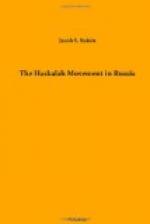With the establishment of the rabbinical seminaries and the ukase (May 3, 1855) that only such may officiate as rabbis as have completed a prescribed course of study, Russian Jewry was placed in a sore predicament. It was a very difficult task to find men who united secular knowledge with that thorough mastery of Talmudic literature which the Jews of Russia exact from their rabbis. Every community was compelled to appoint two rabbis: an orthodox rabbi (dukhovny rabbin) and a “crown,” or Government, rabbi (kazyony rabbin). The people recognized only the authority of the former, the Government that of the latter. The consequence was that a man with a mere high-school education would apply for, and would often receive, the position of crown-rabbi. His duties consisted in merely keeping a register of marriages, births, and deaths, administering the oath, and the like. The many lawyers and physicians who were debarred from practicing their professions sought to become candidates for the rabbinate. To avoid the unpleasant results which followed, Rabbi Chernovich of Odessa and Rabbi I.J. Reines of Lyda established seminaries in Odessa and Lyda, to take the place and to continue the teaching of the Vilna and the Volozhin yeshibot, which had been closed, and to furnish proper rabbis for the various congregations.[19]
The century-long struggle for enlightenment had a telling effect. What the early Maskilim had only dreamed of finally came to be. The metamorphosis was so great and so general as to be hardly credible. It was shown by Mr. Landman, in a paper read before the Russo-Jewish Historical Society of Odessa, that while among the Gentiles of that city the reading public constituted seven per cent of the population, among Jews it was no less than thirty-three per cent, and twenty-five per cent of all readers were Jewish women.[20] By 1905 there were two Yiddish and three Hebrew dailies, besides several weekly, monthly, and quarterly periodicals and annuals in Yiddish, Hebrew, and Russian, notwithstanding the fact that a numerous class depended on the general Russian literary output for their mental pabulum.
As the number of those who read Hebrew was still considerable, Abraham Loeb Shalkovich (Ben Avigdor) began, with the assistance of a number of Maskilim, the publication of “penny literature” (Sifre Agorah, Warsaw, 1893). Shortly afterwards the Ahiasaf Society and, a little later, the Tushiyah Society were founded. The object was to edit and publish “good and useful books in the Hebrew language for the spread of knowledge and the teaching of morality and culture among the Hebrew youth, also scientific books in all departments of learning.” Both these associations have done admirable work. They have published many good text-books for teaching Hebrew and Jewish history, an illustrated periodical for children, Olam Katan (The Little World), and numerous works of interest to the adult. Among their publications were, besides




